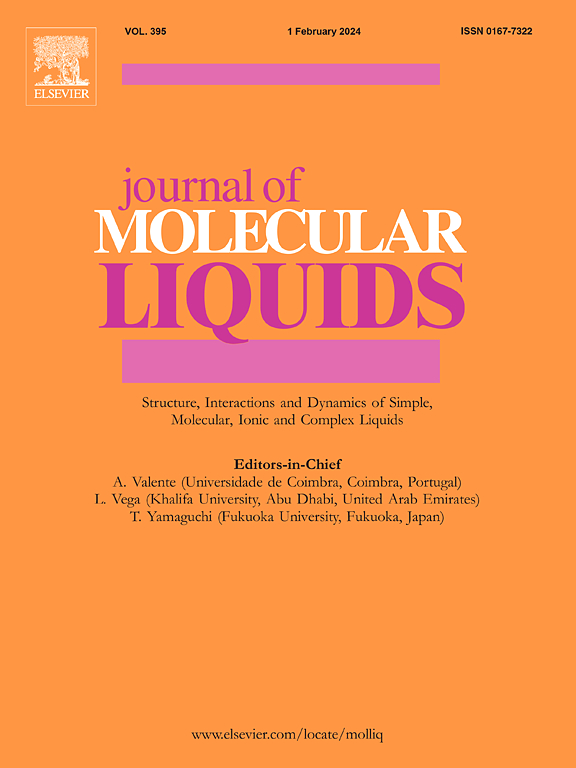四氢呋喃中氢键增强受激拉曼散射过程中的四波混频
IF 5.3
2区 化学
Q2 CHEMISTRY, PHYSICAL
引用次数: 0
摘要
通常,四波混频(FWM)的发生依赖于相应的非线性极化率和相位匹配条件。然而,有人提出氢键(HB)可以增强四氢呋喃(THF)中FWM的SRS信号。在纯THF中,仅在2870 cm−1和2946 cm−1处观察到强CH SRS峰。相比之下,当THF与四氯化碳(CTC)混合时,额外的FWM峰出现在2713 cm−1和3083 cm−1。当THF与CTC的体积比为4:6(摩尔比为2:1)时,THF对FWM的增强效果最强,CTC的全阶Stokes SRS也得到了增强。结合密度泛函理论计算,两种有机分子中形成的HBs对相邻分子之间的振动耦合有很强的影响。氢键的形成促进了种子光子的出现,而CTC的加入和激光诱导等离子体的产生改善了相位匹配环境,调节了非线性磁化率,从而增强了FWM信号。本文章由计算机程序翻译,如有差异,请以英文原文为准。
Enhancement of four-wave mixing in stimulated Raman scattering processes by hydrogen bonding in tetrahydrofuran
Typically, the occurrence of four-wave mixing (FWM) relies on the corresponding nonlinear polarizability and phase-matching conditions. However, it has been proposed that hydrogen bonding (HB) can enhance the SRS signal of FWM in tetrahydrofuran (THF). In pure THF, only strong C![]() H SRS peaks at 2870 cm−1 and 2946 cm−1 are observed. In contrast, when THF is mixed with carbon tetrachloride (CTC), additional FWM peaks appear at 2713 cm−1 and 3083 cm−1. When the volume ratio of the THF and CTC is 4:6 (molar ratio of 2:1), the enhancement of FWM in THF is the strongest, while the all-orders Stokes SRS of CTC is also enhanced. Combined with density-functional theory calculation, the HBs formed in the two organic molecules have a strong influence on the vibrational coupling between neighboring molecules. The formation of hydrogen bonds promotes the emergence of seed photons, while the addition of CTC and the generation of laser-induced plasma improve the phase-matching environment and adjust the nonlinear susceptibility, thereby enhancing the FWM signals.
H SRS peaks at 2870 cm−1 and 2946 cm−1 are observed. In contrast, when THF is mixed with carbon tetrachloride (CTC), additional FWM peaks appear at 2713 cm−1 and 3083 cm−1. When the volume ratio of the THF and CTC is 4:6 (molar ratio of 2:1), the enhancement of FWM in THF is the strongest, while the all-orders Stokes SRS of CTC is also enhanced. Combined with density-functional theory calculation, the HBs formed in the two organic molecules have a strong influence on the vibrational coupling between neighboring molecules. The formation of hydrogen bonds promotes the emergence of seed photons, while the addition of CTC and the generation of laser-induced plasma improve the phase-matching environment and adjust the nonlinear susceptibility, thereby enhancing the FWM signals.
求助全文
通过发布文献求助,成功后即可免费获取论文全文。
去求助
来源期刊

Journal of Molecular Liquids
化学-物理:原子、分子和化学物理
CiteScore
10.30
自引率
16.70%
发文量
2597
审稿时长
78 days
期刊介绍:
The journal includes papers in the following areas:
– Simple organic liquids and mixtures
– Ionic liquids
– Surfactant solutions (including micelles and vesicles) and liquid interfaces
– Colloidal solutions and nanoparticles
– Thermotropic and lyotropic liquid crystals
– Ferrofluids
– Water, aqueous solutions and other hydrogen-bonded liquids
– Lubricants, polymer solutions and melts
– Molten metals and salts
– Phase transitions and critical phenomena in liquids and confined fluids
– Self assembly in complex liquids.– Biomolecules in solution
The emphasis is on the molecular (or microscopic) understanding of particular liquids or liquid systems, especially concerning structure, dynamics and intermolecular forces. The experimental techniques used may include:
– Conventional spectroscopy (mid-IR and far-IR, Raman, NMR, etc.)
– Non-linear optics and time resolved spectroscopy (psec, fsec, asec, ISRS, etc.)
– Light scattering (Rayleigh, Brillouin, PCS, etc.)
– Dielectric relaxation
– X-ray and neutron scattering and diffraction.
Experimental studies, computer simulations (MD or MC) and analytical theory will be considered for publication; papers just reporting experimental results that do not contribute to the understanding of the fundamentals of molecular and ionic liquids will not be accepted. Only papers of a non-routine nature and advancing the field will be considered for publication.
 求助内容:
求助内容: 应助结果提醒方式:
应助结果提醒方式:


